When you’re dealing with flammable liquids in the workplace, one of the key considerations is spill containment and management. Flammable liquids that leak or spill can quickly cause hazards that can affect your staff, your business and the surrounding environment. To help you develop a successful spill response strategy, we’ll be focusing on what you should include in your set of operating procedures. Our aim is to ensure that your business can be fully equipped and ready to successfully respond to a flammable liquids spill.
Developing Your Set of Operating Procedures
Your set of operating procedures should focus on 3 specific areas:
- The initial response – protecting the safety of staff
- Carrying out the clean-up – including the disposing of chemicals
- Reporting the chemical spill – informing authorities
Remember, it’s your legal responsibility under the WHS Act and Regulations, as well as Australian Safety Standards, to have spill management and containment procedures in place.
Every endeavour shall be made to prevent leaks or spills, and to control them if they do occur. Clean-up action shall be initiated immediately.
Australian Standard AS 1940:2017
1. Keeping People Safe
Your initial response to any chemical spill is the protection of human life: by preventing the chemicals from igniting or exploding and containing the risk of environmental damage. While we’ve highlighted the key considerations you’ll make when keeping people safe, you must remember that every spill situation will be different — and the order at which the response happens may vary. For example, in some situations it may be impossible to action the clean-up until the work area has been fully evacuated.
Consider the following points when developing procedures for keeping people safe:
Protect Life
The rapid response to protect life includes taking physical action to ensure first responders are not exposed to the hazards onsite. This means that precautions must be taken to ensure that people are not exposed to dangerous chemical fumes and that they’re not at risk of being engulfed by flames if the flammable liquids were to ignite. When initiating a response to protect life, you must consider what fire equipment and personal protective equipment (PPE) is required to minimise risk in such a situation.
%20for%20flammable%20liquids.jpg?width=390&name=Personal%20Protective%20Equipment%20(PPE)%20for%20flammable%20liquids.jpg) Consider what fire equipment and personal protective equipment will be required to respond to a flammable liquids spill in your workplace.
Consider what fire equipment and personal protective equipment will be required to respond to a flammable liquids spill in your workplace.
Notify Key Responders
When the notification of key responders occurs, it must be a fast and efficient process. Therefore, as part of your operating procedures, you will need to consider who must be notified in the event of the spill. This will include emergency services, as well as supervisors and other departments in your organisation. You must collate a priority list of key responder names that includes their contact details. Also, keep in mind that each person listed on this sheet must have a comprehensive understanding of their response role.
9.4.3 Actions for dealing with leaks and spills
Emergency services should be notified when—
(a) the liquids have spread, or have the potential to spread, beyond the boundary of the installation; (b) it is beyond the resources of the occupiers to clean up the spill or leak effectively and safely;
(c) the protective equipment is inadequate for dealing with the situation;
(d) staff are not experienced in dealing with the situation; or
(e) staff and the public are, or could potentially be, placed at risk.
Fire Safety
As we are all aware, spilled flammable liquids create an immediate fire and explosion hazard. Once the chemicals are released into the workplace, the hazardous flammable vapours can travel long distances while remaining in their flammable range. To address the issue of fire safety, you must consider what potential ignition sources are in the immediate area? You must also develop procedures to ensure you can prevent the flammable liquids from igniting or exploding.
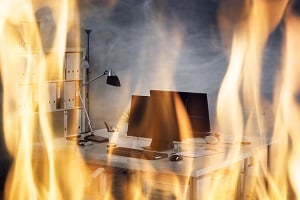 What ignition sources are present in your work areas and how would you stop the chemicals from causing a fire or explosion?
What ignition sources are present in your work areas and how would you stop the chemicals from causing a fire or explosion?
Isolate The Area
Next, you’ll need procedures for isolating the spill site and restricting access. It may be as simple as roping off a small area with hi-vis tape, or you may need to shut down production as well as prevent delivering/loading vehicles from entering the site.
Evacuate
When writing a set of procedures, the evacuation of your organisation is one of the most significant considerations. You must carefully consider a range of questions, including ‘Will the entire job site need to be evacuated, or only the immediate area surrounding the spill?’ You should also consider how staff and other visitors to your worksite could quickly leave the area without putting themselves at risk.
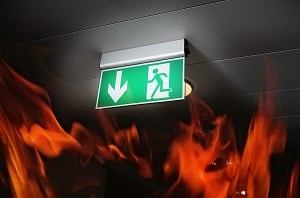
Will you need to evacuate the work area surrounding the flammable liquids spill or will you be required to evacuate your entire organisation?
Environmental Considerations
Environmental damage can be a serious risk when there is a flammable liquids spill. You should consider if the spilled flammable chemicals pose an immediate risk to groundwater, neighbouring pastoral lands or native forestry?
Conducting The Clean-Up
The next part of your spill response procedures will focus on the actual clean-up of the Class 3 Flammable Liquids through controlling the spread, the absorption of the chemicals, the collection and disposal of chemical waste, and the decontamination of your work areas.
Controlling The Spread Of Liquid
Controlling the spread of hazardous substances during a chemical spill is crucial in reducing the potential for harm. Your operating procedures must include clear details on how staff will physically stop the chemical spill and control the spread of the flammable liquid. If you have invested in the appropriate spill containment systems and bunding, you will be able to control the spread of liquids in a more strategic and effective manner. You should consider circumstances such as plugging a punctured fuel drum and shutting off an overflowing transfer line. Consider how your staff will prevent the flammable chemicals from mixing with incompatible substances that are present in your workplace?
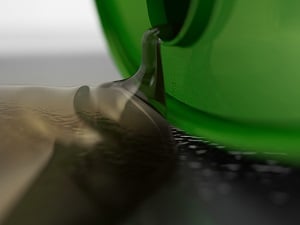 Could your spilled flammable liquids come into contact with any incompatible substances and cause a violent chemical reaction?
Could your spilled flammable liquids come into contact with any incompatible substances and cause a violent chemical reaction?
Absorbing The Liquid
Your procedures must include rules on how to absorb the flammable liquids. What materials and equipment will you need to absorb the liquid? You may need a wide range of materials including sorbent matting, pillows, socks, pads, floating skimmer bags and granular sorbent. What other utensils and tools will you need (eg, non-sparking shovels, brooms, dustpans)?
9.4.2 Clean-up materials and equipment
In order to deal with leaks and spills, a spill response kit shall be readily available where flammable or combustible liquids are stored, dispensed or in transit storage in order to prevent spills from reaching ignition sources, stores of other chemicals, or combustible materials (e.g. timber and paper), or flow into drains or onto neighbouring land, or enter any creek, pond or waterway.
AS 1940:2017
Collecting The Waste
You must consider how your staff will safety collect the clean-up rags and sorbent materials that are now filled with flammable liquids? What PPE will workers need to wear and what containment facilities will you require? You must also consider how you’ll be reducing the risk of fire or explosion during this incident. For example, how will staff carry out this clean-up and waste collection work without generating sparks or static discharge?
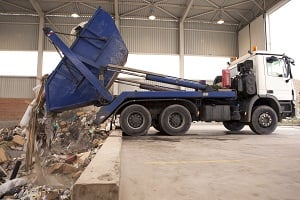
Even when flammable liquid waste is being collected or disposed, there is still the risk that the chemicals will ignite or cause an explosion.
Dispose Of Waste
Now that the flammable liquids are cleaned-up, what is going to happen with the hazardous waste? Consider where the flammable waste will be held until it can be disposed of safely? Do you need to notify local authorities such as the local Council or EPA? Do you have a contact who collect the waste and remove it from your worksite in an appropriate manner?
Decontaminate The Area
The final stage of your chemical spill clean-up will be the effective decontamination of the work area. As part of your operating procedures, you must consider if the soil and surfaces in and around your business been permanently contaminated by the spill? Has the flammable liquids spill now created an ongoing fire, chemical exposure or environmental hazard?
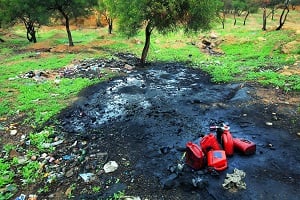
After the clean-up of a chemical spill, you must consider if the site has been permanently contaminated by the flammable liquids.
Reporting The Incident
Once the chemical spill has been cleaned up, you should also have reporting mechanisms to ensure that the WHS Regulator is notified, and the contributing factors to the incident are reviewed internally.
Your procedures must include the following considerations for reporting the spill incident:
Complete A Site Incident Report
Parties to the spill (including the staff involved, witnesses and responders) should complete a site incident report that documents their version of events. These incident reports will also be used as the basis for an incident investigation and follow-up risk assessment.
Notifying the WHS Regulator
Under the WHS Act, every Australian business has a legal responsibility to notify your WHS Regulator of any uncontrolled chemical escape, leak or spill that risks the health and safety of any person — whether onsite or on neighbouring properties.
Conduct An Incident Investigation
We recommend carrying out an incident investigation to identifying causal factors and system failures that contributed to the spill. An investigation can also evaluate spill response and clean-up efficiencies, as well as identify any ongoing hazards.

Carrying out an incident investigation and a risk assessment of your site will allow you to be better prepared in the future for the containment and management of a chemical spill.
Carry Out A Risk Assessment
A chemical risk assessment is an important part of keeping your organisation safe and compliant. If a flammable liquids spill did occur in your workplace, it may have been caused by a previously unknown hazard — or the spill itself may have created new hazards, such as contaminated soil or damaged equipment. You’ll need to conduct a risk assessment to determine how these hazards will impact the future safety of the job site.
What’s Your Spill Response Procedure?
Now that we’ve highlighted the considerations you must make, we hope we’ve given you the knowledge to develop a safe and effective flammable liquids spill response. By developing a written procedure for dealing with chemical spills — and investing in training and drills for your staff — you’ll be reducing the risks associated with Class 3 Flammable Liquids. However, implementing the right risk control measures for flammable liquids stores and work areas is one of the most significant ways that you can minimise risk in your organisation. If you’d like to learn more, why not access our free guide? Essential Considerations When Storing Flammable Liquids Indoors explains how safety cabinets can reduce your spillage risk by providing liquid-tight chemical containment.
Joining the team as a Dangerous Goods Storage Consultant, Melissa Hampton became Storemasta's Marketing Manager in late 2021. With extensive knowledge and experience in chemical compliance, Melissa is responsible for leading the Marketing team and helping shape their marketing strategy. In her spare time, you can find Melissa hiking, swimming and enjoying the great outdoors in beautiful north-west Tasmania.
